< Previous | Contents | Next >
![]()

Warning (Continued)
seat as far back as it will go. It is
better to secure the child restraint in a rear seat.
See Passenger Sensing System 0 91
for additional information.
When securing a child restraint with the seat belts in a rear seat position,
study the instructions that came with the child restraint to make sure it is
compatible with this vehicle.
Child restraints and booster seats vary considerably in size, and some may fit in certain seating positions better
than others.
Depending on where you place the child restraint and the size of the
child restraint, you may not be able to access adjacent seat belts or LATCH
anchors for additional passengers or child restraints. Adjacent seating
positions should not be used if the child restraint prevents access to or interferes with the routing of the
seat belt.
![]()
Wherever a child restraint is installed, be sure to follow the instructions that came with the child restraint system
and secure the child restraint system properly.
Keep in mind that an unsecured child restraint can move around in a
collision or sudden stop and injure people in the vehicle. Be sure to
properly secure any child restraint in the vehicle — even when no child is
in it.
Lower Anchors and Tethers for Children (LATCH System)
The LATCH system secures a child
restraint during driving or in a crash.
LATCH attachments on the child
restraint are used to attach the child
restraint to the anchors in the vehicle.
The LATCH system is designed to
make installation of a child restraint easier.
In order to use the LATCH system in your vehicle, you need a child
restraint that has LATCH
attachments. LATCH-compatible
![]()
rear-facing and forward-facing child seats can be properly installed using either the LATCH anchors or the
vehicle’s seat belts. Do not use both
the seat belts and the LATCH anchorage system to secure a rear-facing or forward-facing child seat.
Booster seats use the vehicle’s seat
belts to secure the child in the booster seat. If the manufacturer recommends that the booster seat be secured with
the LATCH system, this can be done as long as the booster seat can be
positioned properly and there is no interference with the proper
positioning of the lap-shoulder belt on the child.
Make sure to follow the instructions
that came with the child restraint, and also the instructions in this manual.
When installing a child restraint with a top tether, you must also use either the lower anchors or the seat belts to properly secure the child restraint.
A child restraint must never be
installed using only the top tether and anchor.
104 SEATS AND RESTRAINTS
![]()
The LATCH anchorage system can be used until the combined weight of the child plus the child restraint is
29.5 kg (65 lbs). Use the seat belt alone instead of the LATCH anchorage
system once the combined weight is more than 29.5 kg (65 lbs).
See Securing Child Restraints (With the Seat Belt in the Rear Seat) 0 109 or
Securing Child Restraints (With the Seat Belt in the Front Seat) 0 111.
Child restraints built after March 2014 will be labeled with the specific child weight up to which the LATCH system can be used to install the restraint.
The following explains how to attach a child restraint with these
attachments in the vehicle.
Not all vehicle seating positions or child restraints have lower anchors
and attachments or top tether anchors and attachments. In this case, the seat belt must be used (with top tether
where available) to secure the child restraint.
See Securing Child Restraints (With the Seat Belt in the Rear Seat) 0 109 or
Securing Child Restraints (With the Seat Belt in the Front Seat) 0 111.
![]()
Lower Anchors
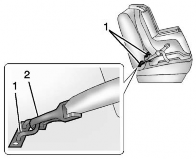
Lower anchors (1) are metal bars built into the vehicle. There are two lower
anchors for each LATCH seating position that will accommodate a child restraint with lower
attachments (2).
![]()
Top Tether Anchor
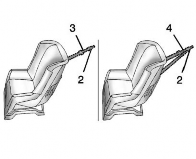
A top tether (3, 4) anchors the top of the child restraint to the vehicle.
A top tether anchor is built into the
vehicle. The top tether attachment (2) on the child restraint connects to the top tether anchor in the vehicle in
order to reduce the forward movement and rotation of the child restraint
during driving or in a crash.
The child restraint may have a single tether (3) or a dual tether (4). Either will have a single attachment (2) to
secure the top tether to the anchor.
Some child restraints with top tethers are designed for use with or without
the top tether being attached. Others require the top tether always to be
attached. In Canada, the law requires that forward-facing child restraints
have a top tether, and that the tether be attached. Be sure to read and
follow the instructions for your child restraint.
Lower Anchor and Top Tether Anchor Locations
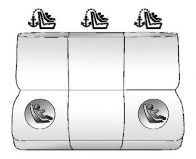
Rear Seat
I : Seating positions with top tether anchors.
![]()
H : Seating positions with two lower anchors.

To assist in locating the lower
anchors, each seating position with
lower anchors has two labels, near the crease between the seatback and the
seat cushion.

To assist in locating the top tether
anchors, the top tether anchor symbol is on the cover.
![]()
![]()
SEATS AND RESTRAINTS 105

The outboard lower anchors are
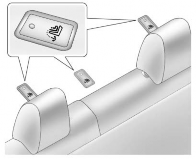
behind the vertical openings in the seat trim.
106 SEATS AND RESTRAINTS
![]()
The top tether anchors are behind the rear seat, on the filler panel. Open the covers to access the anchors. Be sure
to use an anchor on the same side of the vehicle as the seating position
where the child restraint will be placed.
Do not secure a child restraint in a
position without a top tether anchor if a national or local law requires that
the top tether be attached, or if the
instructions that come with the child restraint say that the top tether must be attached.
According to accident statistics,
children and infants are safer when
properly restrained in a child restraint system or infant restraint system
secured in a rear seating position. See
Where to Put the Restraint 0 102 for additional information.
![]()
Securing a Child Restraint Designed for the LATCH System

{ Warning
A child could be seriously injured or killed in a crash if the child
restraint is not properly attached to the vehicle using either the LATCH anchors or the vehicle seat belt.
Follow the instructions that came with the child restraint and the
instructions in this manual.

{ Warning
To reduce the risk of serious or
fatal injuries during a crash, do not attach more than one child
restraint to a single anchor.
Attaching more than one child
restraint to a single anchor could
cause the anchor or attachment to come loose or even break during a crash. A child or others could be
injured.
![]()

{ Warning
Children can be seriously injured or strangled if a shoulder belt is
wrapped around their neck. The shoulder belt can tighten but
cannot be loosened if it is locked. The shoulder belt locks when it is pulled all the way out of the
retractor. It unlocks when the
shoulder belt is allowed to go all
the way back into the retractor, but it cannot do this if it is wrapped
around a child’s neck. If the
shoulder belt is locked and
tightened around a child’s neck, the only way to loosen the belt is to
cut it.
Buckle any unused seat belts behind the child restraint so
children cannot reach them. Pull
the shoulder belt all the way out of the retractor to set the lock, and
tighten the belt behind the child restraint after the child restraint has been installed.

{ Warning
The power seats will work with the ignition off. Children could operate the power seats and be injured.
Never leave children alone in the vehicle.

Caution
Do not adjust the power seat when a child restraint is installed.
Adjusting the seat may cause damage to the installed child
restraint. Use the window lockout button on the driver door to
prevent adjustment of the seat whenever a child restraint is
installed.
![]()

Caution
Do not let the LATCH attachments
rub against the vehicle’s seat belts. This may damage these parts.
If necessary, move buckled seat
belts to avoid rubbing the LATCH attachments.
If you need to secure more than one child restraint in the rear seat, see
Where to Put the Restraint 0 102.
This system is designed to make
installation of child restraints easier. When using lower anchors, do not use the vehicle's seat belts. Instead use
the vehicle's anchors and child
restraint attachments to secure the restraints. Some restraints also use
another vehicle anchor to secure a top tether.
1. Attach and tighten the lower attachments to the lower
anchors. If the child restraint
does not have lower attachments or the desired seating position
does not have lower anchors,
secure the child restraint with
![]()
SEATS AND RESTRAINTS 107
![]()
the top tether and the seat belts.
Refer to the child restraint
manufacturer instructions and
the instructions in this manual.
1.1. Find the lower anchors for the desired seating
position.
1.2. Put the child restraint on the seat.
1.3. Attach and tighten the
lower attachments on the
child restraint to the lower anchors.
2. If the child restraint
manufacturer recommends that
the top tether be attached, attach and tighten the top tether to the
top tether anchor, if equipped.
Refer to the child restraint
instructions and the following steps:
2.1. Find the top tether anchor.
2.2. Open the top tether anchor cover to expose the anchor.
![]()
![]()
108 SEATS AND RESTRAINTS
2.3. Route, attach, and tighten the top tether according to your child restraint
instructions and the
following instructions:
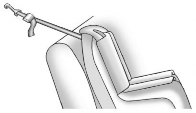
If the position you are using does not have a
headrest or head restraint and you are using a single tether, route the tether
over the seatback.
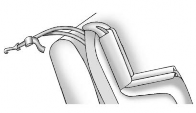
If the position you are using does not have a
headrest or head restraint and you are using a dual
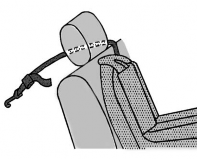
tether, route the tether over the seatback.
![]()
If the position you are
using has an adjustable
head restraint and you are using a single tether, route the tether around the
inboard side of the head restraint.
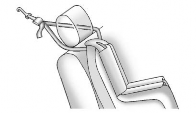
If the position you are
using has an adjustable
headrest or head restraint and you are using a dual
tether, fully raise the head restraint and route the
tethers around the out board side of the Head Restraint posts.
3. Before placing a child in the
child restraint, make sure it is
securely held in place. To check, grasp the child restraint at the